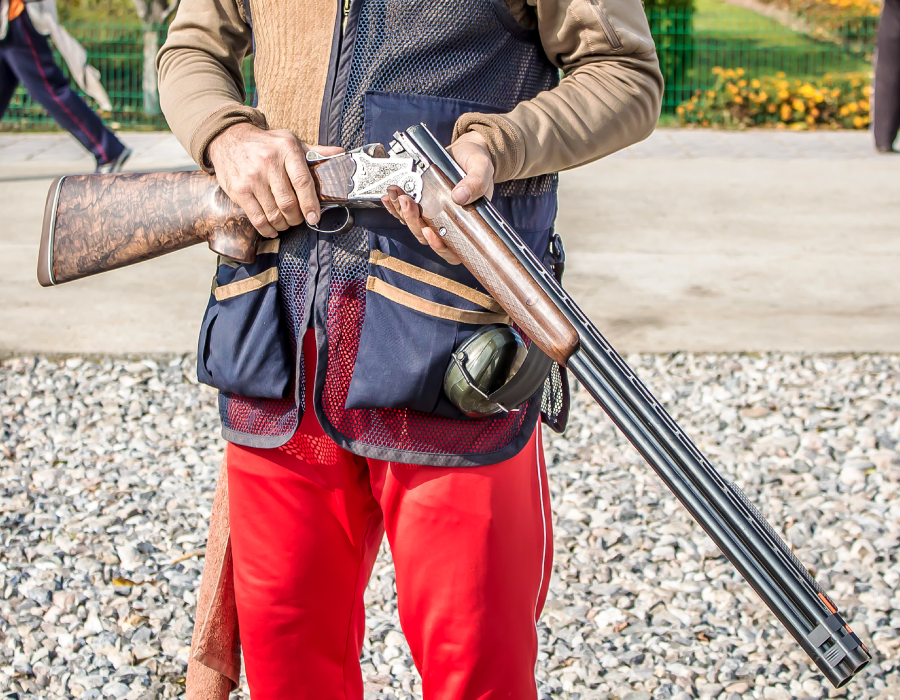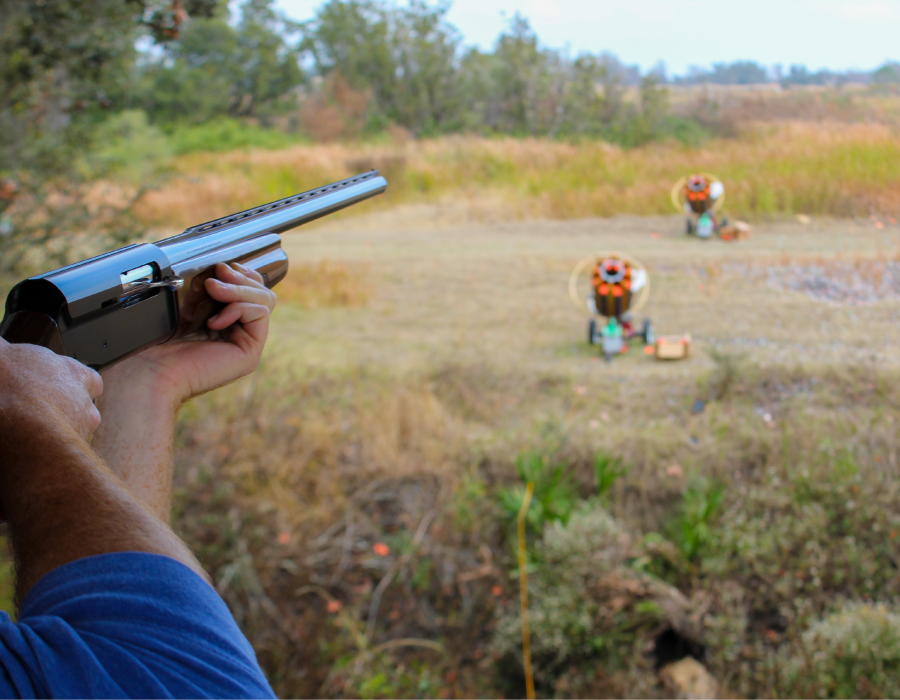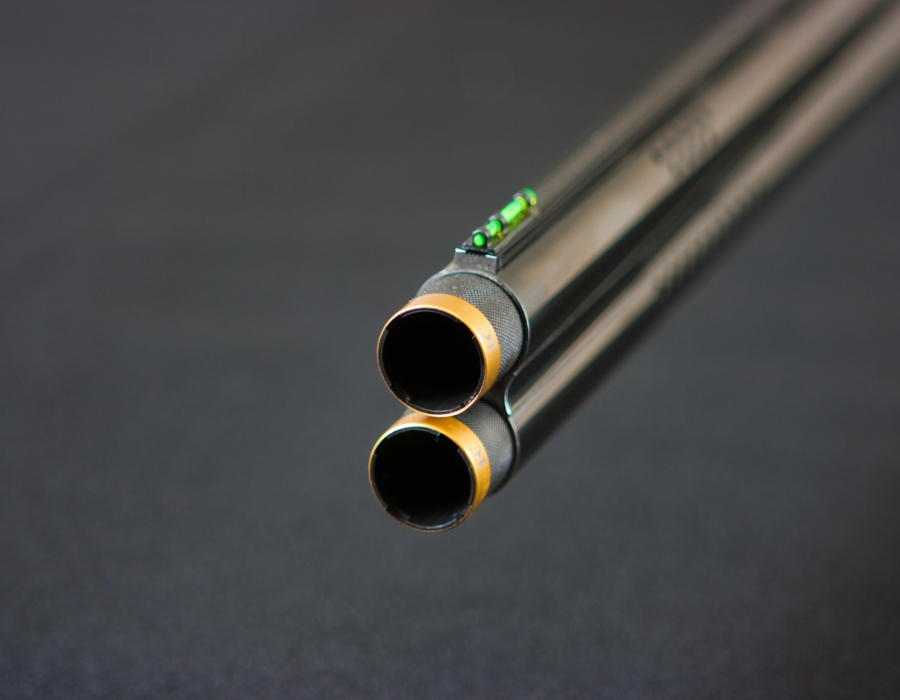The Sporting Clay is gaining more and more fans. Moreover, it is a discipline that brings together a very large number of practitioners because it can intrigue both shooters and hunters. This activity can be defined as the link between the two worlds. On the one hand, we are targeting the clay pigeons, and on the other, they are launched unpredictably, with trajectories that simulate the movement of game as much as possible.
This is not a trivial matter if you prefer a natural environment where you can test yourself in close contact with the surrounding area, but not only. The Sporting Clay, as we will see later is divided into two branches (Sporting and Compak), is also an excellent way to familiarise yourself with a shotgun.
Since the trajectories are noticeably different from each other, you have to challenge yourself with various shooting techniques, which can be easily learnt, even faster than with traditional Olympic disciplines. Moreover, you can use a few types of hunting shotguns, and we will take a look at which ones so that the neophytes and hunters can become familiar with the clay pigeons without taking on ulterior expenses in the beginning due to changing shotguns.
Now let’s go into detail and find out how a Sporting Clay is done.

Two specialities and unexpected launches: put yourself to the test with the Sporting Clay
The Sporting Clay is anything but sedentary. Indeed, it manages to combine a passion for shooting with that of hunting perfectly. It is divided into two specialities, Sporting and Compak, but before talking about the differences, let’s focus on the common characteristics: the launch pattern of the clay pigeon.
Having to simulate the movement of various game as much as possible, the launch patterns are carried out following and imitating flight paths or motions. Some targets are set up thinking about imaginative paths, to make the shot even more spectacular and engage the shooter.
Alternatively, there are two practices:
Sporting: is very much associated with hunting. Those who choose Sporting, in fact, find themselves going from one shooting position to another, in natural environments. A particular passage between the woods and open spaces that is very reminiscent of a hunter’s way of moving, with a path that winds through nature.
Compak: is much more similar to the “traditional” Olympic disciplines. In this speciality, you do not move within natural environments, but the shooter must confront the targets in five locations. By putting oneself inside predetermined platforms, the overall view is certainly clearer, since the launch area is marked off.
Another feature of the Sporting Clay is the particular pattern with which the targets are launched, which is different from the various Olympic disciplines, where the target makes some movements that are defined as “standard”.
In the Sporting or Compak competitions, you can find the most imaginative variables (it is the federation’s rules that suggest that you always put yourself to the test). But some versions have become classic launch patterns because they are used frequently for their spectacularity.

Rabbits, turtledoves or “candles”. Launch patterns in the Sporting Clay
Let’s take a quick look at the most used launch patterns in the two specialities, to concentrate on the advice on how to break the most targets. Some of these launches take their name from the game that simulates the movement.
Turtledove plate: two targets are thrown to the sides of the platform and make completely different journeys. There are three main variables linked to the trajectory: they can have the same trajectory and start at a short distance; they can have different directions but start from the same location; they can start from several stations with different trajectories.
Rabbit plate: in this case, the target will roll on the ground very quickly. This is made possible by a machine that hurls it at ground speed. It has remarkable speed, and since it comes into contact with the ground, it also bounces. The movement of this target, which reminds us precisely of a rabbit, depends on the morphology of the field, which accentuates or not the “hops”, and the position from which the target is fired.
The Candle: is considered one of the most difficult launch patterns to hit, in which the plate is thrown upwards at a perpendicular speed. The problem with hitting the target lies in understanding its actual speed and calculating the time to hit it. Some prefer to fire with the “candle” uphill, some wait for it to slow down and some opt to aim for it while it descends, waiting for the right moment to shoot.
Double plates: two plates are thrown in sequence, even if the shooter does not know when the second will start or from which location. So, the difficulty lies precisely in identifying when it is best to hit each target.
Plate “from behind”: the target starts from behind the shooter, with the plate passing over their head. Height is one of the variables to be considered, as is the trajectory, which can have particular angles. This is surely one of the hardest launch patterns because the shooter does not know where the target will come from, but sees it practically entering the range in a flash. In this case, the plate should be intercepted as soon as possible, to avoid that, by going too far, its trajectory becomes too complex.
Pull and Mark: Skeet launches are widely used in the Sporting Clay, using Pull and Mark traps, which are typical of this discipline.
Mini plate: instead of using the “classic” target, a smaller plate is preferred to increase the difficulty.
How to break more clay pigeons: some tips for the Sporting Clay
Now that we have seen the main features of the Sporting Clay, we can define the useful suggestions for hitting as many targets as possible.
The correct shooting position
There are various schools of thought on how to adjust one’s body before taking up a shotgun. Some suggest a position with very wide legs, others less. A good solution is to position them with the same width as the shoulders since in this position one can move with greater fluidity.
Then there are the torso and the pelvis: placed slightly further back; they allow more “soft” and precise movements.
The gaze
To take the right aim, the important thing is the observation of the target. We advise you to choose a visual area that is not too large; it is better to concentrate on where we imagine the clay plate to appear. It is important, however, to always keep the corner of your eye turned to the trap, the point from which our target will be launched.
The target must then be “focused”. This may seem banal and straightforward, but that is not always the case. Look clearly, without focusing your attention on the shotgun or other things.
As the experts say, you can’t hit a target without seeing it: maximum concentration on the target, rather than everything else.
Attention to the speed of the target and the shotgun
A factor that must always be considered is the speed of the target and the shotgun. The target will follow its trajectory, and our movements with the shotgun must be as synchronised as possible. This ability must be learnt as soon as possible to be more effective in the field.
As soon as you see the plate, position yourself in the shooting area, rotate the shotgun at the same speed as your shoulders, learning to use your legs and shoulders well.
Furthermore, the grip, we repeat, should be soft: firm, but not too tight.

Some effective shooting techniques
We also want to highlight two methods for hitting the target:
With targeted or accompanied shooting, it is necessary to identify the breaking point and the starting area of the target. Both must be connected to the barrels, thus accompanying the shotgun. Therefore, it is good to place your legs firmly on the ground to have the right harmony in the movement. This method is ideal for longer shots, where it is possible to understand the path of the target well.
With instinctive shooting: you need swift reflexes. In this case, the plate passes the shotgun, with the target being left just under or above the trajectory. Meanwhile, try to get as close to it as possible. In essence, we need to identify the point at which we believe the target will be found, a little further on or higher than where it is now.
Here is the most effective shotgun for the Sporting Clay
As with the various Olympic shooting disciplines, you also need the right equipment to follow a Sporting Clay. As for the shotgun, the type that best suits your needs is an over-and-under for target-shooting, preferred over the over-and-under for hunting because it would be too light.
Why this shotgun? There are many advantages. First of all, because the two barrels will work better on different bottlenecks and cartridges, to adapt to the number of targets and pulls, which in the Sporting Clay are very different from each other. So, even the shooting selector is decisive, because it allows you to choose the first barrel from which to start the shot.
The overlapping barrels, during the recoil, also have fewer lateral shifts than a double-barreled gun. And, although heavier than the semi-automatic shotguns, it has, because of its size, a smaller upswing after the shot. This is an indispensable factor in double launches.
Obviously, even if the over-and-under shotgun is the best for the Sporting Clay, that doesn’t mean that a semi-automatic shotgun cannot be used. In this discipline, it is possible to use all types of smooth-bore rifles. The semi-automatic shotguns, due to their simplicity of use, are very comfortable. On the other hand, with this shotgun, we will have to be content with the same bottleneck for both shots.
The length of the barrels is very important. Because the more pronounced they are, the more we will be able to lengthen the line of sight, then follow the target. In the Sporting Clay, the clay targets are launched at very different angles and trajectories, and having a soft shotgun is certainly positive.
Shooters normally opt for a length varying from 76 to 80 centimetres, although some even choose to increase the measurements further. On the one hand, this will be beneficial concerning your accuracy; on the other, you risk the lowering of the barrel. Important in this case will be the balancing of everything.
As for the stock, it is necessary to adapt it as much as possible to the physiognomy of one’s body. Take a look at the countless adjustments of our Futur-K6-AM.
Can I use a hunting shotgun for the Sporting Clay?
There are downsides to using hunting shotguns. These shotguns are designed to shoot at a lower frequency than those for target sports. They are also designed to be transported easily and, as a result, are lighter: this means more recoil.
With modern semi-automatic shotguns, the question changes. They are sturdy and, if they are of excellent quality, they can be easily held on the Sporting Clay.

